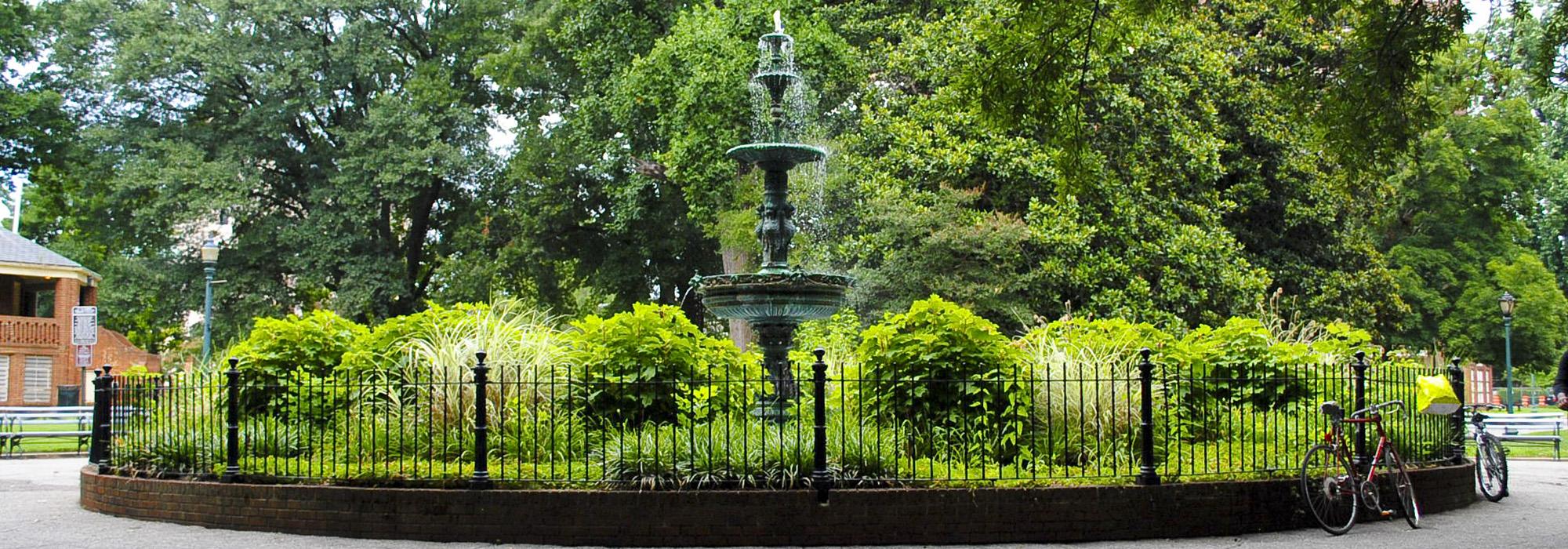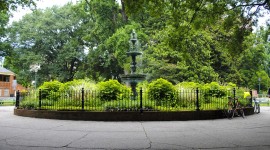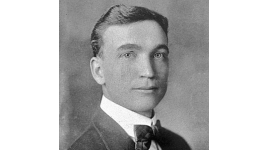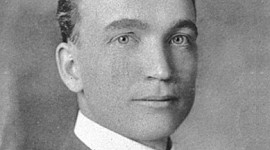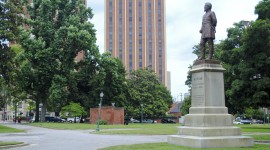An Unfortunate Addition to Richmond’s Monroe Park
Since its establishment in 1851, Monroe Park has been an important cultural and recreational resource for the City of Richmond. In recent years the city has invested millions of dollars in revitalizing the National Register-designated landscape and updating its infrastructure. While the renovations are nearly complete, an electrical control unit, placed just feet from the park’s World War II Monument designed by celebrated Richmond landscape architect Charles Gillette (1886-1969), has significantly diminished the integrity of the park’s visual and spatial relationships.
History
Purchased by Richmond’s Committee on Public Squares in 1851, this 7.5-acre parcel west of downtown became the city’s first municipal park and is named for President James Monroe. The site was used as fairgrounds and, later, as a Civil War encampment. Anticipating Richmond’s westward expansion, city engineer Charles H. Dimmock designed Monroe Park as a resource for the new neighborhoods in 1869, implementing a rambling, curvilinear system of pathways with informal groupings of vegetation. In 1876 civil engineer Wilfred Cutshaw reconfigured the relatively flat site, employing a radial network of walkways likely inspired by a visit to the Centennial Exhibition in Philadelphia that same year. The walks converge at a ronde point with a pyramidal, rusticated granite fountain in the center, acting as a focal point and gathering place within the park. This circulation system, which remains essentially unchanged, proved successful, aligning walkways with prominent building sites around the park and efficiently linking the sides and corners of the five-sided parcel. The granite pyramid was replaced in 1903 by an ornamental, four-tiered, cast-iron fountain executed by J.W. Fiske. Between 1891 and 1911, three memorials were added to the landscape, including local sculptor Edward Valentine’s Wickham Monument, William Couper’s bronze statue of Joseph Bryan, and the granite Fitzhugh Lee Monument (artist unknown). A circa-1890 band shell was replaced in 1939 by the Checkers House, an octagonal Art Deco pavilion. Several improvement projects were executed for the park’s centennial in 1951, including updated plantings and a World War II Monument designed by landscape architect Charles Gillette.
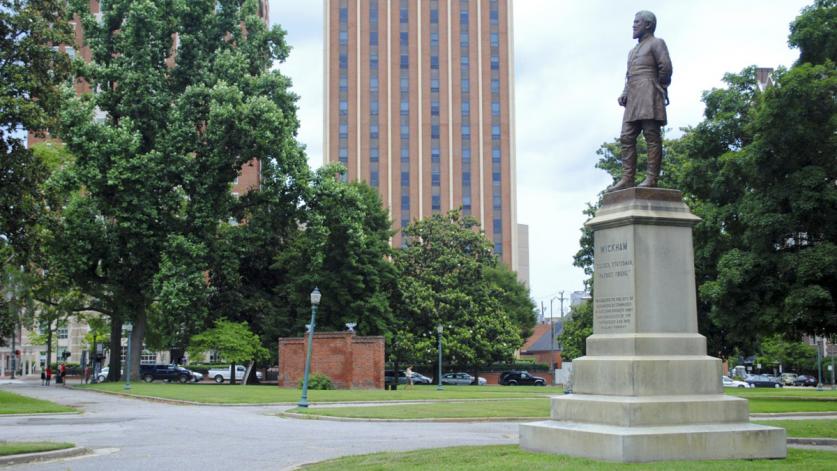
A prolific designer who would complete some 2,500 projects in a career spanning five decades, Gillette entered the profession in 1909 as an apprentice at the firm of Warren Manning in Boston. In 1912 he opened his own practice in Richmond. While most of his projects were in Virginia or North Carolina, Gillette’s work received national recognition, and by the time he was asked to design the World War II Monument he was a significant figure in landscape architecture. The monument is located on a lawn in the northwest corner of the park and comprises a brick wall adorned by a pair of eagles and flanked by two granite benches. The front of the wall faces east and bears limestone steles inscribed with the names of Richmond citizens who died during the war. The largest monument in Monroe Park, it is a focal point for parkgoers and can be seen from much of the park’s northern section.
The park borders Virginia Commonwealth University and is a resource for the campus and surrounding neighborhoods. Although investment in the park waned during the latter half of the twentieth century, the Monroe Park Historic District was listed in the National Register of Historic Places in 1984. Recognizing its potential as a landmark and a successful public space, the City of Richmond adopted a master plan for Monroe Park in 2008 to revitalize the site while remaining sensitive to its historic character.
Threat
In November 2016 Monroe Park was closed for extensive renovations, including upgrades to its infrastructure and electrical systems, as well as stormwater retention and lighting. Paving and fixtures were updated, as was the park’s plantings. The $7 million project is being managed and facilitated by the Monroe Park Conservancy, a nonprofit that raised $3 million in private funds to help complete the work. In exchange for these efforts, the City of Richmond granted the conservancy a 30-year lease in 2014 to oversee the park’s renovation and future operation.
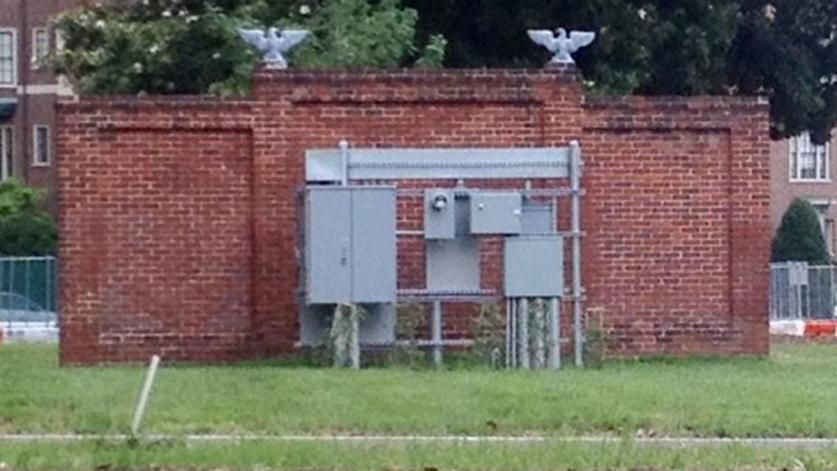
In May 2018, an 800-Amp electrical control station was erected directly adjacent to the World War II Monument’s rear facade. The electrical station was originally planned for a location near Pine and Main Streets. The placement of the station mars views of the monument from the park’s western entrance and along North Laurel Street. The electrical station is readily visible from either direction along the path extending between the park’s fountain plaza and the northern entrance. Its placement greatly diminishes the historic visual and spatial experience of Monroe Park and thwarts years of planning by many stakeholders. Perhaps most importantly, it impedes the monument’s purpose as a place of remembrance and respect for those who served during World War II.
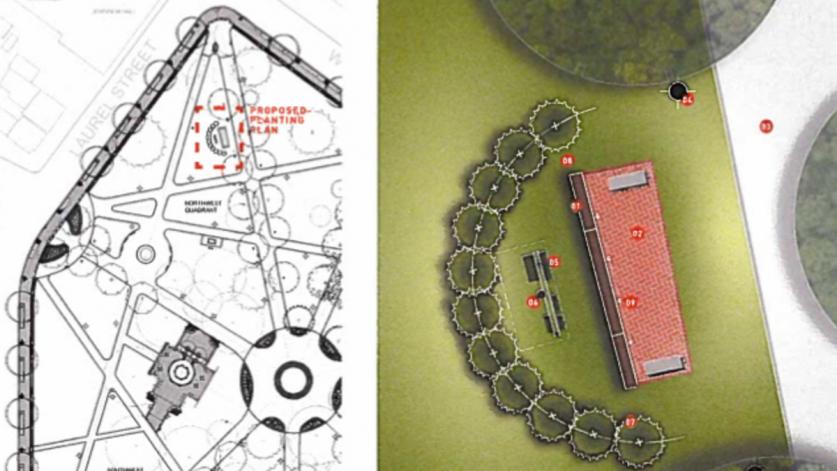
The electrical station was discovered by neighborhood residents in May 2018, and it was placed in the park without input from the City of Richmond’s Planning Commission, the Monroe Park Conservancy, or the office of Virginia’s State Historic Preservation Officer. A recently devised plan would attempt to camouflage the electrical control station with a coat of paint and conceal it behind an arcing line of magnolias, which, when fully mature, would obscure the memorial entirely from the west and change its appearance when viewed from all other directions. Rather than attempt to disguise the electrical control station, the unfortunate choice made for this publicly owned landscape and memorial site should be reversed immediately, before the blight is permanently enshrined within the park.
What You Can Do to Help
The City of Richmond’s Planning Commission was notified of the electrical control station’s placement in May. Thanks to public pressure, the issue is now on the agenda of the Commission’s Urban Design Committee (UDC), which is scheduled to meet on August 9, 2018. A final decision is set to follow on August 20. Additional public input could greatly influence that decision.
Contact members of the UDC in advance of the meeting and urge them to recommend relocating the electrical control station to a more appropriate site. E-mail the Secretary of the UDC, fill out an online form, or call the UDC at (804) 646-6335 with your concerns.
The public can also attend the UDC meeting on August 9, 2018, to voice concerns directly:
Richmond City Hall
900 E. Broad Street
5th floor conference room
Richmond, VA 23219
Charles Woodson served on the Monroe Park Advisory Council from 2003 until its dissolution in 2011. He lives in Oregon Hill, an historic district adjacent to Monroe Park, and is president of the Oregon Hill Neighborhood Association.



